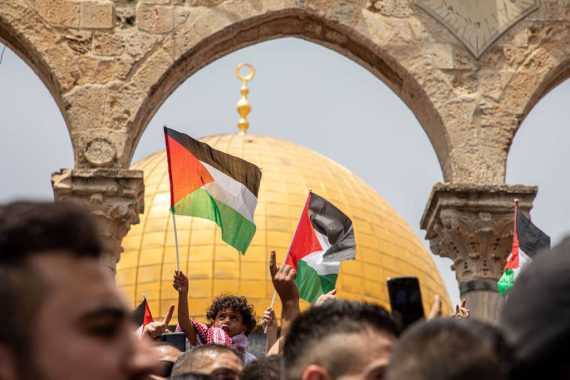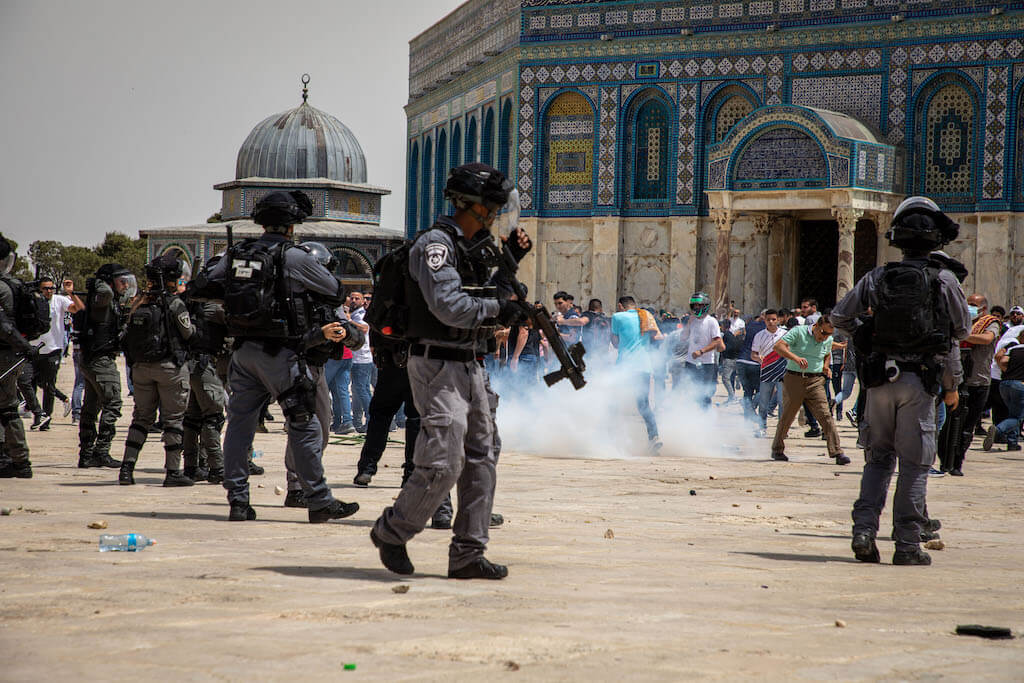Palestine is back on the map. There’s no question about that. But who put it there, who’s taking the credit for the Palestinian resistance’s defeat of Israel’s infamous “Iron Dome”, who will benefit from proving Israel’s military vulnerability, and who will lead the Intifada 3.0 that has revived hopes for millions of people around the world who want to see Jerusalem saved from expanded occupation?
On paper, the most vocal and aggressive Palestinian resistance groups, inside Palestinian territories, are Hamas and the Islamic Jihad. With the latest round of military actions, they’ve proven, some would argue, that they are the strongest flag bearers for the cause of Palestinian freedom. Israel’s vulnerable nature was broadcast around the world as news outlets and the internet became flush with videos of barrages of rockets flowing out of Gaza at dozens of targets including Israel’s largest seaport Ashdod, the nearby Israeli settlement of Sderot, the seaside city of Ashkelon, Israel’s capital Tel Aviv, and Jerusalem. Even though the “Iron Dome” managed to intercept a large number of incoming rockets, as Israel claimed, some did pierce the defense system.
According to Israeli sources 4,375 rockets were fired from the besieged Gaza Strip between May 9 – and May 20. More than 90% of them were intercepted by Israel’s “Iron Dome” missile defense system. The Palestinian resistance rockets caused extensive damage to Israeli infrastructure and killed 13 Israelis.
Targets included military bases, economic centers, and residential neighborhoods; much like the targets targeted by Israeli jets and drones. However, the Israeli operations, both offensive and the “Iron Dome” operation, came at a much higher financial cost than the Palestinian resistance had to incur. Something that will further pinch Netanyahu’s struggling political career. This is where the Palestinian succeeded to expose Israel’s military vulnerabilities.
According to Israeli experts, Palestinian short-range rockets fired at Israel cost between $300 – $800 each. The cost of longer-range rockets, like “Ayyash-250”, that targeted Ramon airport, is unknown. On the other hand, every rocket fired by the “Iron Dome” system carries a cost of $35000 – $100,000. The launcher system, known as “Tamir” holds 20 rockets, each with a range of 20km. Israel conducted over 1,000 interceptions according to some sources putting the cost of operating the “Iron Dome” at $35 to $100 million over a span of 11 days.
The question is how did Palestinian resistance groups manage to deal such a heavy blow to one of the most advanced and powerful militaries in the world?
The system identifies incoming rockets, decides which pose a threat, and launches a counter projectile to neutralize the threat in the air. But despite the highly advanced military technology and more than $1.3 billion worth of research and development put into developing the “Iron Dome”, Palestinian rockets managed to rain down on Israel changing the balance of power in the Palestine-Israel battle space for the foreseeable future.
The question is how did Palestinian resistance groups manage to deal such a heavy blow to one of the most advanced and powerful militaries in the world?
Following the announcement of a ceasefire that began on May 21, Hamas leaders spoke publicly about Israel’s capitulation to the Palestinian resistance’s military capabilities. Ismail Haniyeh and Khalid Mishaal boasted about the success of Palestinian resistance in the face of all odds.
In fact, Hamas leaders’ public statements overlooked a number of strategic victories achieved in their most recent parlay with Israel, including but not limited to: proving Palestinian military capabilities despite the 14 year-siege of Gaza, proving siege tactics are not enough to squash the Palestinian resistance, forcing Israel to endure huge costs to prevent even more damage to Israel, exposing Israel’s security vulnerabilities via the large scale widespread civil disobedience witnessed by the entire world via live stream, and proving its capacity to influence public sentiment deep inside occupied territories and in areas administered by the Palestinian Authority headed by Mahmoud Abbas. To the dismay of millions around the world, all of these achievements, were subdued by an unsurprising Egypt brokered ceasefire announced by Israel and precariously accepted by Palestinian resistance groups.

VIDEO: How Hamas’ Leader in Gaza Reacted to the Ceasefire
Hamas and other Palestinian resistance groups didn’t hesitate to declare the 11 day assault a victory. Palestinians and their supporters celebrated the achievement both at home and abroad. But Hamas had a peculiar message of thanks following the notable skirting of perceived Israeli military might. Ismail Haniye, Hamas’ political chief, thanked Iran publicly, as well as Egypt, Qatar, and Turkey. But Iran was especially praised for its financial and tactical support to the Palestinian resistance. He directly credited the Palestinian resistance’s surprisingly effective arsenal to financial, military and tactical support from Iran.
But this isn’t the first time Hamas has thanked Iran for such support. Similar statements were made following Israeli assaults on Gaza in 2008, 2012, 2014 and in between. It’s well known that Hamas has relied on various types of support from Iran and its proxies including Hezbollah and the Iranian Revolutionary Guard to build its arsenal and military capabilities. But such messages of thanks to Iran received mixed reactions, especially in the Arab world. Iran has used the Palestinian issue as a marching chant for decades and slogans like “death to Israel” have become common place in its cadres. However, during the latest 11-day exchange of fire Iran and its proxies didn’t go into action.
Iran has proxy forces in a number of Middle East countries and especially in Lebanon and Syria. However, only three rockets were reported to have been launched from Syria at Israel during the 11 days and two of them landed in Syria. It isn’t clear who launched them. In southern Lebanon, at least four rockets were launched at Israel, causing no damage at all. Furthermore, protesters gathered at the border with Israel in Lebanon in support of Palestine scaling the border wall and destroying security cameras.
One protester was even shot by Israeli forces and later died of their wounds. Social media accounts boasted that the young man was a Hezbollah member and called him a martyr. At the same time, social media accounts published videos showing Hezbollah members detaining participants and scolding them for getting involved in the protests. While all of this was happening Palestinian groups, according to Hamas, who received support from Iran, were firing non-stop barrages of rockets at Israel, while Israel conducted airstrikes killing 248 people including 67 children and 39 women.
The potential for a larger scale operation were ripe and people around the world were waiting in angst for Intifada 3.0. But to the behest of many, nothing happened, no notable rocket fire by Iran happened, no ground forces amassed at the many borders with Israel controlled by Iran, and Jerusalem, along with the rest of Palestine, remains occupied by Israel.
One question in many people’s minds, but few are willing to ask, is why Iran didn’t put into action their tens of thousands of proxy fighters based in Syria, Lebanon and even Iraq. Iran funds and supports the Hash al Shaabi in Iraq, or Popular Mobilization forces, who came into the scene as part of the U.S. led international coalition’s Operation Inherent Resolve, to defeat the Daesh terror group.
Recommended
In Syria there are more than 100,000 Iran backed militants in various capacities and in a variety of locations, including near the Golan Heights and the Lebanese border. Iran also controls a logistics route connecting Tehran, Baghdad, Damascus and Beirut. Iranian proxies and their leaders including from Lebanese Hezbollah and the IRGC move freely between the four countries. The Iranian proxies have heavy and advanced weapons in their arsenal including medium range and long-range rockets, as well as tanks and armored vehicles.
They also have anti-tank guided missiles and heavy artillery as well as a large arsenal of small caliber artillery as well as vehicles mounted machine guns and ammunition to go along. More importantly, they have influence over tens of thousands of eager ideologically motivated fighters ready to use those weapons when the orders come in.
But history will show that during Gaza’s May 2021 conflict, and the widespread Palestinian defiance of Israeli aggression, deep inside occupied territories, as well as Israel, was not enough to bring that large cache of weapons and fighters into action. Yahya Sinwar, the recently released former prisoner and now head of Hamas explained the axis of resistance’s lack of action in a televised speech. He said that he was personally in touch with Iranian officials and the commander of Lebanese Hezbollah Hasan Nasrallah who offered their help, but Hamas rejected.
The justification is that the recent assault on Gaza and ensuing counter operation by Palestinian resistance groups was only a test of the resistance’s ability to hurt Israel and not a fight for liberation of Alaqsa. Now there’s talk of Hamas reopening their diplomatic channels with Damascus as well. Of course, a gesture that is fully backed by Iran, a renewed relationship with Damascus would allow Hamas to continue their hit and run campaign against Israel with even more depth. For several years, Hamas hasn’t been on the good side of the Assad family ever since some of its leadership spoke openly of their support for anti-regime protesters. Some of Hamas’ leadership that once took shelter in Syria was forced to flee to neighboring countries.
But that may all change now. Osama Hamdan, a member of Hamas’ political bureau, made the clearest statement following the latest Gaza – Israel standoff saying that Assad has been a loyal and consistent supporter of the resistance efforts. Some high -level Hamas supporters including Saleh Alnamy denounced the statement. According to Hamdan, Assad’s Arab origin and commitment to opposing Israel is well known. Of course, Hamdan overlooked the fact that the few rockets launched at Israel from Syria were completely ineffective. One could understand from Hamdan’s statements that the hundreds of thousands of people killed by Assad, backed by Iran, over the past decade, were only steppingstones towards the liberation of Jerusalem.
What’s become clear is that a permanent solution to the Palestinian issue won’t be resolved as long as it depends on parties that have a capacity to mobilize huge amounts of resources effectively and efficiently but aren’t willing to use them for the cause of liberation. Intifada 3.0 brought a new status quo into place: Palestine will remain occupied until those with limited resources are willing to risk what little they have in the cause of freeing the holy land from the clutches of politically and ideologically driven Zionist occupation regardless of who funds and supports them.






